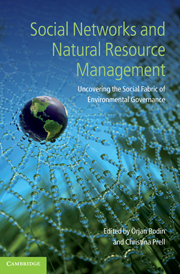 Social Networks and Natural Resource Management
Social Networks and Natural Resource Management 14 - Social network analysis in natural resource governance – summary and outlook
from Part III - Summary and outlook
Published online by Cambridge University Press: 05 June 2012
Summary
The relational approach in natural resource governance
Our intention with this book has been to introduce the social relational approach to scholars and practitioners who, in one way or another, are interested and/or engaged in natural resource governance. At this point, we hope that all the studies presented in this book have conveyed the message that a social relational approach, coupled with formal analytical methods (captured under the term Social Network Analysis (SNA)), can help one acquire new and exciting insights on a number of natural resource governance issues – conceptually, analytically, and practically.
Making use of SNA in the context of natural resource governance is an emerging field of research, and as such, much work is needed in exploring, in depth, the ways a relational approach to natural resource governance can lead to new and/or better theories, insights, tools, and techniques.
- Type
- Chapter
- Information
- Social Networks and Natural Resource ManagementUncovering the Social Fabric of Environmental Governance, pp. 347 - 373Publisher: Cambridge University PressPrint publication year: 2011
References
- 1
- Cited by


